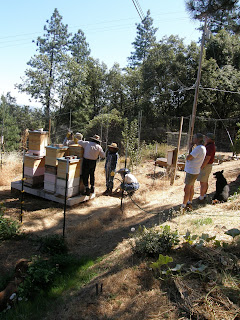The day was perfect for our purposes, neither too hot nor too cool, with a cloudless sky and a lovely soft breeze. Early in the morning I was out in the courtyard garden, pruning back exuberant growth to completely clear the path between the hives and my studio, where the honey extraction would take place. David, meantime, was shearing weeds from around the hives to make access easier and also to reduce the danger of fire from the smoker, the device used to calm the bees.
While I was working in the garden, a 3-gallon pot of water was coming to a boil on the stove, in preparation for the next phase, the sterilizing of the jars that would hold the honey. We assembled half-pints, pints, quarts and 2-quart jars, each of which had a turn in boiling water and then was placed upside-down in a box. This procedure is carried out with long tongs and a potholder and is never free from sudden scalding splatters that are a foretaste of the stings to come.
David laid out tarps over the Persian rugs in the studio and set up the centrifuge, a hand-cranked contraption about three feet tall and two feet in diameter, on the raised hearth of the woodstove. I stacked the sterilized jars on my big studio worktable. David cleaned and laid out the two specialized combs used for uncapping the honey, and secured paint filters over the mouths of two food-grade buckets, with bungee cords.
At 1 PM, our crew began to arrive: our neighbors, Mark and Peggy, who are part of our bee co-op; David’s older son, Eric, also a member, and his girlfriend, Kelley; another neighbor, John; and a friend who had never worked bees before, but wants to learn, Julie. David, Eric, Kelley and Julie suited up in hats with bee veils, long sleeved tops and gloves, heavy jeans and boots. Ankles and wrists were secured with duct tape, to keep the bees from crawling in and stinging, and off they went to the hives, an odd-looking band of warriors.
Mark, Peggy, John and I observed from afar, as the first hive was opened, but soon the first frames full of honey, weighing between 5 and 8 pounds, arrived, and our work began.
I brushed bees from the frames, combed the wax from the surface to uncap the hexagonal comb and release the honey, and put the first 2 frames into the centrifuge.
John and Mark took turns turning the crank. After 4 frames had been spun, the centrifuge refused to turn, the sign that the honey needed to be drained.
This is a magical moment, the culmination of a year’s tending of the bees. The filtered bucket is placed below the centrifuge, the petcock is opened and out flows a rope of golden honey an inch and a half thick. Its amber color is gorgeous, its consistency voluptuous, and its fragrance ravishing. We all stood in wonder, as the shining rope uncoiled into the filter.
When the centrifuge was drained, the bucket was hoisted onto the worktable and Peggy began filling jars from the petcock at the bucket’s base. Meanwhile, David arrived with more frames bulging with honey and removed the harvested frames, to replace them in the hives. The bees will work their magic on the tattered comb and in just a few days, the perfect hexagons will be restored and will begin filling up with honey, again.
So it went, all afternoon, as our feet began to stick to the tarps and every step resulted in a tearing sound. The frames were heavy and showed graphically where one dispensation of flowers had ceased and another had begun to bloom. Some frames had half pale gold honey and half that was almost black. The flavors of these two were so distinct that we developed the discrimination of wine connoisseurs in tasting them. The pale honey had a sharp, clear flavor with a slightly sour and peppery under-note, while that dark honey was almost like caramel.
When all was accomplished around 5 PM, we had gleaned 9 and a half gallons, or 114 pounds, of honey! Our warriors were hot from being taped into their armor and all had been stung at least once and some, multiple times. Those of us at the other end of the operation were hot and sticky but unscathed by the bees, despite a veritable airfield of flying creatures buzzing around us. We all hoisted icy Tsing Tao beer and toasted the honey harvest and our work as a community.
Those are the mechanics of a home honey harvest. Nothing, however, can convey the mystery of honey, its rich fragrance redolent of our local spring and summer flowers, its mysterious amber depths and the transmutation that is wrought by the bees. That is the subject for poetry and contemplation, and must await another day and another mode of writing.








No comments:
Post a Comment